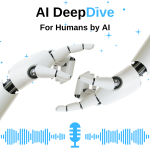
From Models to Deployment: the Road to Production
This podcast explores the essential components for building and deploying AI applications, including models (mathematical functions for data processing), prompts (instructions for the model), knowledge (data sources for training), integrations (connecting AI to real-world systems), testing (ensuring quality and reliability), and deployment (running applications in production). It emphasizes the significance of open-source models, highlighting their role in maintaining data privacy and regulatory compliance while enabling companies to innovate effectively.